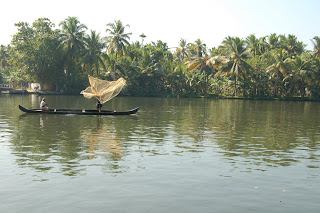
From Pondicherry, we decided to rent a scooter for ease of getting around. Since it is quite a touristed city, there are rental stands all around the city center. We stopped at the first stand that we saw, with the rental bicycles and scooters parked along the side of the street. (We had attemped to rent a proper motorcycle, but there were no Enfields available). Tim left his PADI diving card as identification and a 500 Rs (10USD) deposit. The owner pulls out a coke bottle of gas and puts about half of that into the tank, enough to get us to the gas station. And like that, we were off on two wheels to explore the area. Our destination was Auroville, an international community north of Pondicherry. It was a fun ride 20km to our destination. We left a bit later than we had meant to, as we ran into some friends and time slipped away quickly as we were hanging out with them. In the waining light, we followed our friend's directions back to the main road. 'Turn right, then another right...follow that path until you reach pavement....even though you think you are on the wrong route'. A proper dirt road turns into a single lane path. Next thing we know, we are driving through a small village, weaving in and out of small huts as people are beginning to prepare their dinners. Our friend's words echo through my head 'even though you think you are on the wrong route...' as we wind our way through the village, but on the other side we did indeed reach the pavement. Our little headlight didn't cast a very bright light on the dark lane, but it was quite easy driving. However....things really began to pick up as we hit the main road heading down to Pondicherry. Tim was just sticking with traffic and I felt like we were flying....until I peered over his shoulder and our speedometer put us at a mere 40km/h! Our headlight did nothing to point out any speedbumps or potholes in the road up ahead. Then as we reached Pondicherry the two lane road was buzzing with motorcycles, rickshaws, bicycles, busses, cows, stray dogs, pedestrians, and merchants pushing carts. The lane was completely clogged with traffic and there are seemingly no traffic rules other than remaining upright and avoiding collisions. People turn into the uncoming traffic and weave their way over to their side of the road. At intersections, the first to arrive gets to pass....so Tim would gun it each time we arrived at an intersection and it seemed clear enough. My heart was racing and I clutched to Tim tightly. I shared a little 'I love you!' with him, so thankful that he was driving as I knew we would be dead at the side of the road if I had been placed in control of the scooter. You would never guess that the two of us had spent 6 months traveling by motorcycle through Latin America!! We immediately sought a cool beer to settle the nerves, and I realized I am perfectly happy watching the traffic mayhem from the window of a bus. Of all the time we spent on two wheels, nothing even comes close to the chaos of traffic here.

































